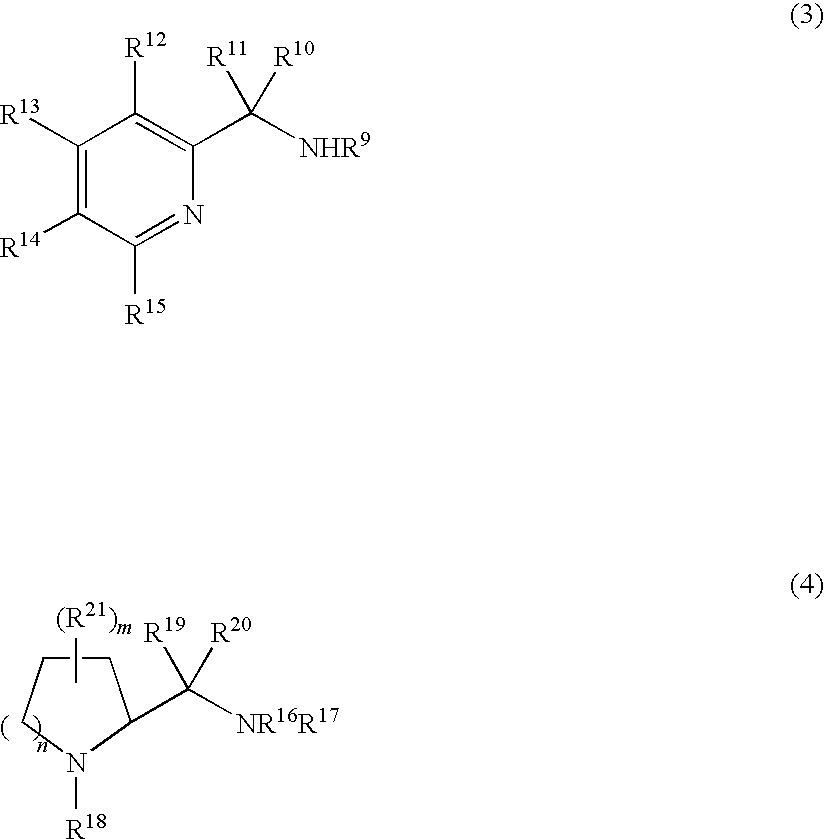Process for Production of Optically Active Quinuclidinols
a quinuclidinol, optically active technology, applied in the direction of organic compound/hydride/coordination complex catalyst, ruthenium organic compound, chemical process catalyst, etc., can solve the problem of complex operation including repeated re-crystallization for more than several times, and without desired activity, enantiomer without physiological activity does not have useful effect, etc. problem, to achieve the effect of high yield, high steric selectivity and excellent economic efficiency and production cos
- Summary
- Abstract
- Description
- Claims
- Application Information
AI Technical Summary
Benefits of technology
Problems solved by technology
Method used
Image
Examples
example 1
Synthesis of RuBr2-[(S,S)-xylskewphos](pica)
(1) Synthesis of Ru[(S,S)-xylskewphos](methylallyl)2
[0100](S,S)-XylSKEWPHOS (110 mg, 0.2 mmol) and Ru(cycloocta-1,5-diene)(methylallyl)2 (64 mg, 0.2 mmol) were placed in a 50-mL Schlenk tube replaced with argon. Then, hexane 5 mL was added and the mixture was stirred at 70° C. for 6 h. The insoluble material was filtered by a glass filter, and the solvent was distilled off.
(2) Synthesis of RuBr2-[(S,S)-xylskewphos]
[0101]Under an argon atmosphere, the Ru[(S,S)-xylskewphos](methylallyl)2 complex (153 mg, 0.2 mmol) synthesized in (1) was dissolved in 15 mL of acetone, added with 47%-HBr methanolic solution (0.046 mL, 0.4 mmol), degassed and stirred at room temperature for 30 min. After distillation of the solvent, the residue was used for the subsequent reaction without purification.
(3) Synthesis of RuBr2-[(S,S)-xylskewphos](pica)
[0102]Under an argon atmosphere, 2-picolylamine (21.6 mg, 0.2 mmol) was placed in the RuBr2-[(S,S)-xylskewphos] c...
example 2
Synthesis of RuCl2-[(S,S)-3,5-diEtskewphos](pica)
[0104](S,S)-3,5-diEtSKEWPHOS (56 mg, 0.084 mmol) and [RuCl2(p-cymene)] (26 mg, 0.043 mmol) were placed in a 50-mL Schlenk tube replaced with argon. Then, dimethylformamide (3 mL) was added and the mixture was degassed and stirred for 5.5 h while being heated at 100° C. Then, 2-picolylamine (9.1 mg, 0.084 mmol) was added and the mixture was degassed and stirred at room temperature for 16 h. The solvent was distilled off to obtain 76 mg of RuCl2-[(S,S)-3,5-diEtskewphos](pica) (95% yield).
[0105]31P-NMR spectrum (161.7 MHz, C6D6): δ40.09 (d, J=58 Hz), 31.76 (d, J=58 Hz).
example 3
Synthesis of RuBr2-[(S,S)-tolskewphos](pica)
[0106]Synthesis was carried out similar to the Example 1, except that TolSKEWPHOS was used as the diphosphine compound in place of XylSKEWPHOS, and 129 mg of RuBr2-[(S,S)-tolskewphos](pica) (95% yield) was obtained.
[0107]31P-NMR spectrum (161.7 MHz, C6D6): δ63.0 (d, J=43 Hz), 44.1 (d, J=45 Hz).
PUM
| Property | Measurement | Unit |
|---|---|---|
| carbon number | aaaaa | aaaaa |
| optically active | aaaaa | aaaaa |
| optical purity | aaaaa | aaaaa |
Abstract
Description
Claims
Application Information
 Login to View More
Login to View More - R&D
- Intellectual Property
- Life Sciences
- Materials
- Tech Scout
- Unparalleled Data Quality
- Higher Quality Content
- 60% Fewer Hallucinations
Browse by: Latest US Patents, China's latest patents, Technical Efficacy Thesaurus, Application Domain, Technology Topic, Popular Technical Reports.
© 2025 PatSnap. All rights reserved.Legal|Privacy policy|Modern Slavery Act Transparency Statement|Sitemap|About US| Contact US: help@patsnap.com



